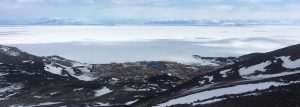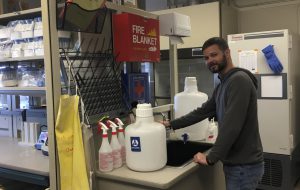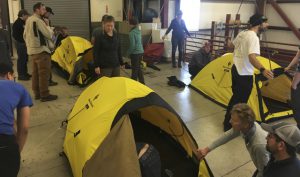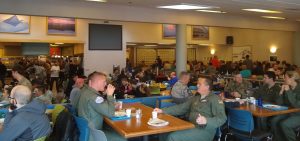Although we were scheduled to fly to the Lake Hoare camp Monday morning (12 Nov), we are still in McMurdo. Another weather system has been ploughing through the region pushing everybody’s field plans back. Since we are staying put at least till Wednesday, I thought I’d give you a tour around “McTown” and point out how it fits to our project.

Credit – DL Porazinska
As of today, there are 853 people on the station and while ultimately science is what brings us all here, the number of actual scientists is not very high. Instead, the great majority of people are those who run the station and through their work enable scientists do their science. Clearly, the entire McMurdo community stands behind the success of every science project.
McMurdo is located on the Ross Island that came to exist through volcanic activity of Mt. Erebus. McMurdo itself has a footprint of 620 acres and spans more than 100 buildings including a science lab, dorms, field party and cargo warehouses, a fire house, power and water plants, construction and mechanics shops, and aircraft and communication facilities.
One of the most important buildings for scientists is the Crary Science Lab.

Credit – DL Porazinska
All science groups request a lab and/or office space and organize it from scratch as needed. How and with what we equip that space is negotiated in early April and later carefully selected, validated, and assigned to us by the Crary Lab crew. Although our lab is initially entirely empty, like with a touch of a magic wand, the stockroom staff makes quick deliveries of all the assigned to our group items and in a few hours we have a fully functioning lab with freezers, centrifuges, and microscopes.

Photo credit – DL Porazinska
The Berg Field Center is another important building for any team heading out to the field. By the time we arrive to McMurdo, our field items (e.g., tents, sleep kits, sleds and backpacks) are already sorted by the BFC crew and waiting for us in cargo cages. All we need to do is double check the quality of all items and pack them for shipping to the field. The BFC’s crew assistance does not end here, however. They work with the Field Stop crew to get us trained to survive under harsh filed conditions. They also work with us whenever our needs have to be adjusted.
The Mechanical Equipment Center is where we go for help with things like drills and badgers for getting sediment samples from cryoconite holes when they are still frozen. The MEC crew can fix, modify, or build adapters to ensures that all equipment is in its top functioning state.
Helicopter crew consisting of scheduling and coms supervisors, pilots, heli techs and mechanics work tirelessly to keep us moving between the town and different filed destinations (e.g., the Dry Valleys). But they also work with field camp managers (e.g., at the Lake Hoare), so that scientists do not have deal with basic details like managing food, fuel, or waste.

Credit – DL Porazinska
The Galleyis where we meet during scheduled times for meals. To feed the entire station requires careful planning and coordination among cooks, kitchen staff, and cleaners. Although we often grumble about the lack of “freshies”, there is plenty of food available around the clock. The most popular meal by far is Sunday brunch that offers special treats (e.g., a cheese platter, smoothies, smoked salmon) in addition to a typical menu. But the Galley also provides a space for Sunday night lectures where scientists like to share their stories with the entire community.
There are plenty of other buildings with their staff that support science. How McMurdo Station is Run is one of the YouTube videos that make it more clear and there are many others. I encourage you to google them up. Also, here is the first episode on the Cryoconite Holes Project for this season.
I just got a word that are on the help manifest for Wednesday. Till the next time! Cheers!
 0
0
